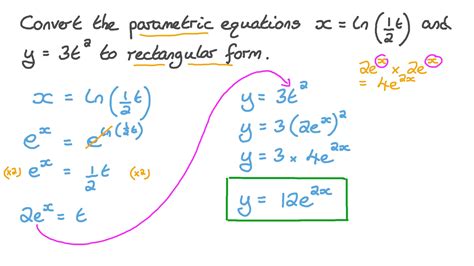Converting parametric equations to rectangular form is a crucial skill in mathematics, particularly in calculus and analytic geometry. Parametric equations represent the coordinates of a point on a curve or surface using a third variable, known as the parameter. However, in many situations, it's more convenient to work with the rectangular form of an equation, where the coordinates are expressed in terms of x and y only. In this article, we'll explore the 5 steps to convert parametric equations to rectangular form.
Understanding Parametric Equations

Parametric equations are a set of equations that express the coordinates of a point on a curve or surface in terms of a third variable, usually denoted as t or θ. These equations are commonly used to model the motion of objects, describe curves and surfaces, and analyze complex systems. However, parametric equations can be cumbersome to work with, especially when trying to visualize the curve or surface they represent.
The Need for Rectangular Form
Rectangular form, on the other hand, represents the coordinates of a point on a curve or surface in terms of x and y only. This form is often more intuitive and easier to work with, especially when graphing or analyzing the curve or surface. Converting parametric equations to rectangular form can help simplify calculations, reveal important properties of the curve or surface, and provide a more comprehensive understanding of the underlying mathematics.
Step 1: Identify the Parametric Equations

The first step in converting parametric equations to rectangular form is to identify the parametric equations themselves. These equations usually come in the form:
x = f(t) y = g(t)
where f(t) and g(t) are functions of the parameter t.
Example:
Consider the parametric equations:
x = 2t + 1 y = t^2 - 3
In this example, the functions f(t) = 2t + 1 and g(t) = t^2 - 3.
Step 2: Solve for the Parameter

The second step is to solve for the parameter t in terms of x or y. This can be done by rearranging one of the parametric equations to isolate t. For example, we can solve for t in terms of x by rearranging the first parametric equation:
t = (x - 1) / 2
Alternatively, we can solve for t in terms of y by rearranging the second parametric equation:
t = ±√(y + 3)
Note that we may obtain multiple solutions for t, which can lead to multiple branches of the curve or surface.
Example:
Using the parametric equations from Step 1, we can solve for t in terms of x:
t = (x - 1) / 2
or in terms of y:
t = ±√(y + 3)
Step 3: Substitute the Parameter

The third step is to substitute the expression for t into the other parametric equation. This will eliminate the parameter t and yield an equation in terms of x and y only.
Example:
Substituting the expression for t in terms of x into the second parametric equation, we get:
y = ((x - 1) / 2)^2 - 3
Simplifying this equation, we obtain:
y = (x^2 - 2x + 1) / 4 - 3
Step 4: Simplify the Equation

The fourth step is to simplify the resulting equation to its standard form. This may involve expanding, factoring, or rearranging terms to obtain a more recognizable or convenient form.
Example:
Simplifying the equation from Step 3, we get:
y = (x^2 - 2x - 11) / 4
Step 5: Verify the Solution

The final step is to verify that the resulting equation is indeed the rectangular form of the original parametric equations. This can be done by checking that the equation satisfies the original parametric equations for all values of t.
Example:
We can verify that the equation y = (x^2 - 2x - 11) / 4 is indeed the rectangular form of the original parametric equations by plugging in values of t and checking that the resulting points satisfy the equation.
Now that we've completed the 5 steps to convert parametric equations to rectangular form, let's summarize the key takeaways:
- Identify the parametric equations and solve for the parameter t.
- Substitute the expression for t into the other parametric equation.
- Simplify the resulting equation to its standard form.
- Verify that the resulting equation is indeed the rectangular form of the original parametric equations.
By following these steps, you can convert parametric equations to rectangular form and gain a deeper understanding of the underlying mathematics.
We hope this article has helped you understand the process of converting parametric equations to rectangular form. If you have any questions or need further clarification, please don't hesitate to ask. Share your thoughts and experiences in the comments section below, and don't forget to share this article with your friends and colleagues who may find it helpful.
What are parametric equations?
+Parametric equations are a set of equations that express the coordinates of a point on a curve or surface in terms of a third variable, usually denoted as t or θ.
Why convert parametric equations to rectangular form?
+Converting parametric equations to rectangular form can help simplify calculations, reveal important properties of the curve or surface, and provide a more comprehensive understanding of the underlying mathematics.
What are the 5 steps to convert parametric equations to rectangular form?
+The 5 steps are: (1) identify the parametric equations, (2) solve for the parameter t, (3) substitute the expression for t into the other parametric equation, (4) simplify the resulting equation, and (5) verify the solution.
